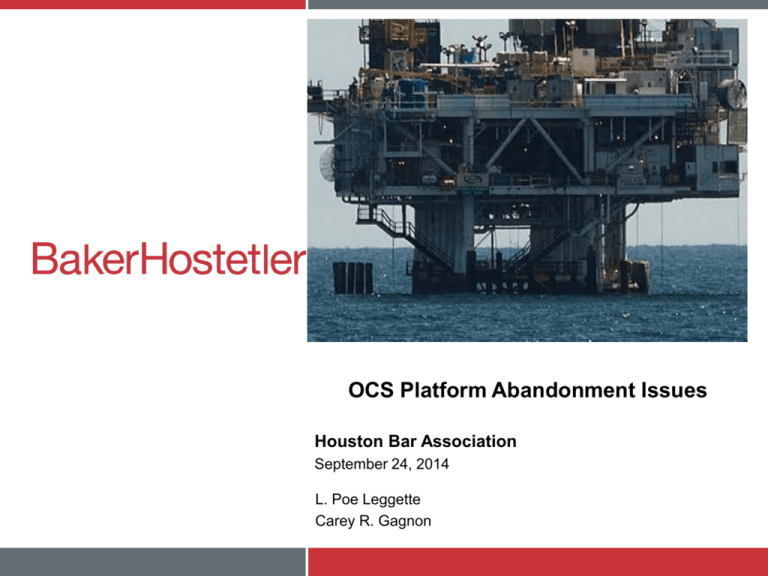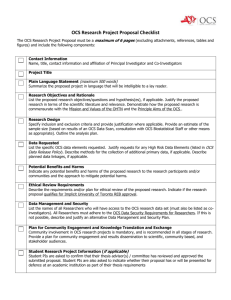
OCS Platform Abandonment Issues
Houston Bar Association
September 24, 2014
L. Poe Leggette
Carey R. Gagnon
Denver corpse flower draws strong
crowds despite weak odor
The Denver Post
08/19/2015
2
Assignments: OCS Regulations
•
Assignment of interest in OCS lease requires federal
lessor’s approval. 30 C.F.R. § 556.62(a); OCS Lease
Form § __
•
Assignment effective as to the federal lessor on the date
specified in the approval letter.
3
Assignments: OCS Regulations
•
“You, as assignor, are liable for all obligations that
accrue under your lease before the date that the
Regional Director approves your request for
assignment….” 30 C.F.R. § 556.62(d).
•
“Your assignee and each subsequent assignee are
liable for all obligations that accrue under the lease after
the date that the Regional Director approves the
governing assignment.” § 556.62.
•
(Emphasis in both added.)
4
BSEE Accrues; Lessees Lose
•
•
•
“It depends on what the meaning of ‘accrues’ is.”
(Anonymous deposition testimony).
30 C.F.R. § 250.1702: Decommissioning liability
accrues when:
– wells are drilled
– platforms built
– pipelines laid
Joint and several liability, § 250.1701
– The current regulations treat all lessees, operators,
and operating rights interest owners as jointly and
severally liable for all lease and RoW obligations.
5
Private Law Considerations
•
“The [federal OCS] regulations govern the parties’ joint
and several liabilities vis-à-vis the Government, not
amongst themselves.” Fruge ex. Rel. Fruge v. Parker
Drilling Co., 337 F.3d 558, 563 (5th Cir. 2003).
•
Principle applied in context of decommissioning in GOM
Shelf, LLC v. Sun Operating Ltd. P’ship, 2008 WL
901482 (S.D. Tex. 2008)
6
Texas Contract Law
•
Texas bellwether: Seagull Energy E&P, Inc. v. Eland
Energy, Inc., 207 S.W.3d 342 (Tex. 2006).
•
Lease subject to JOA. Non-operator “A” assigns its
undivided interest to “B”. After assignment, B fails to
pay operator certain post-op costs. Can operator hold A
liable for B’s breach?
•
Plain English answer: yes, unless the JOA expressly
says no.
7
Texas Contract Law
•
In less plain English, why?
•
Generally, unless the contract makes the contrary clear,
assignment of a contract does not relieve the assignor’s
obligation to the original “obligee.” 207 S.W.3d at 346.
•
“[A]s a general rule, a party who assigns its contractual
rights and duties to a third party remains liable unless
expressly or impliedly released by the other party to the
contract.” Id. at 347 (citing authorities hoarier than your
grandfather (may he be blessed)).
8
Texas Contract Law
•
•
•
•
•
What does an express release look like?
Something that says “release” or “novation.”
The following fails: “Any well abandonment or platform
removal … shall be accomplished by Operator with the
costs … to be shared by the Parties owning such well or
platform in proportion to their Participating Interests.”
Lessee A argued that, because it no longer had a
participating interest after the assignment, it had 0% PI
and $0 obligation.
Lessee A thought wrong.
9
Texas Contract Law
•
•
•
The following succeeds (probably): [Upon “withdrawal”
from the JOA and assignment of the party’s interests to
the other JOA members], “the withdrawing Party shall
thereafter be relieved from all further obligations and
liabilities with respect to such Lease.” 207 S.W.3d at
346 n. 2 (dictum-ish).
What if the contract expressly makes the assignor liable
for “obligations previously incurred [before the
assignment]?” Is that enough to free the assignor from
post-assignment obligations?
Yes, says Indian Oil Co., LLC v. Bishop Petroleum Inc.,
406 S.W.3d 644, 657 (Tex. App. 14th Dist.) (Boyce, J.).
10
Texas Contract Law
•
•
•
So, does this common law rule on assignment operate
“by cruel fate, and giddy Fortune’s furious fickle wheel?”
Henry V, Act 3, Scene 6.
Why would I ask if the answer were not “yes?”
An assignor can be liable for damages caused postassignment to the obligee; but cannot claim damages
for post-assignment breaches by the obligee. Republic
Petroleum LLC v. Dynamic Offshore Resources NS
LLC, __ S.W.3d __, 2015 WL 5076700 at *4 (Tex. App.
1st Dist.). If the second half of the proposition is read in
isolation, it makes good sense. It just seems
asymmetrical.
11
Louisiana Civil Code
•
•
•
Because the Mineral Code does not address the
“effects flowing from the transfer of working interests by
one working interest owner to other working interest
owners[,]” the Civil Code governs. Union Oil Co. of
California v. Cheyenne Oil Properties, Inc., 839 So. 2d
1170, 1174-75 (La. App. 3rd Cir. 2003).
Civil Code art. 1821: “The obligee’s consent to the
[assignment of the] agreement does not effect a release
of the obligor. The unreleased obligor remains solidarily
bound with the third person.”
So, Texas and Louisiana principles are similar.
12
Louisiana Civil Code
•
•
•
•
•
Davis Oil Co. v. TS, Inc., 145 F.3d 305 (5th Cir. 1998), is
relevant, but so factually remote that it is not intrinsically
noteworthy. But it pitted two Titans of the Fifth Circuit—
Jerry Smith and Edith Jones—against one another.
How can we not discuss it?
State of Louisiana issues lease to Davis in 1976. Lease
requires clean up of site upon termination.
Davis assigns all its interest in 1981. Assignee agrees
to assume all of Davis’s obligations under the lease.
Lease is assigned three more times, expires in 1985.
Last assignee fails to restore the site.
13
Louisiana Civil Code
•
•
•
•
In 1988, Canadian liquor maker, Hiram Walker, acquires
Davis’ assignee, making it a sub of a sub of a sub, and
assumed the assignee’s oil and gas businesses.
“In 1992, the State of Louisiana summoned all listed
operators [in the title chain] to a hearing to determine
which should pay for cleanup. Only Davis Oil
appeared.” 145 F.3d at 307. State gives Davis the full
bill.
Could Davis make Walker’s sub pay?
Judge Smith (plus one): yes. Judge Jones, no
(“majority cites the applicable law but evidently does not
understand what it means”).
14
Back to Texas OCS Briefly
and California OCS Oddly
•
•
•
•
Darn little case law on assignments of OCS leases in
context of platform abandonment.
GOM Shelf, LLC v. Sun Operating Ltd. P’ship, cited
earlier, conerned JOA for OCS lease off Texas.
JOA had language about assignor retaining liability for
obligations “accruing on or prior to” Interior’s approval of
the assignment. JOA relieved assignor of “all
obligations … which accrue subsequent” to approval.
By operation of § 4(a) of OCSLA, 43 U.S.C. § 1333(a),
federal law “adopted” Texas law as federal for purpose
of interpreting the contract.
15
Back to Texas OCS Briefly
and California OCS Oddly
•
•
•
Court says the “no liability for obligations accrued after”
assignment language is “not a valid release.” 2008 WL
901482 at *10. [Would Judge Boyce agree with that?]
Court appeared influenced by JOA’s repeated
references to OCS regulations and noted the federal
rule approach to “accrue.”
Held: assignors still liable for plugging and abandoning
the lease and its wells.
16
… and to California OCS Oddly
•
•
•
•
•
If the Department of the Interior breaches an OCS
lease, is the lessee relieved of its lease duty to abandon
the site?
Hah, are you kidding? Of course not. So far….
Noble Energy, Inc. v. Jewell, __ F. Supp.3d __, 2015 WL
3544371 (D.D.C. June 8, 2015).
Court refuses to interpret lease contract in light of
common law doctrine, but instead gives Interior
“substantial deference” to its interpretation of the
decommissioning regulations.
Held: Interior’s breach did not discharge Noble’s duty to
abandon under the regulations.
17
Summing Up So Far
•
•
•
•
•
•
•
To avoid these problems when drafting for a client who
wants to further liability, some rules of thumb:
Mere assignment doesn’t get you off the hook.
Express language making you free of obligations after
assignment may—or may not—get you off the hook.
Obligee’s mere consent to assignment probably does
not get you off the hook.
Express release by obligee is the only sure way.
And what are the odds of that?
“It’s not 98%. It’s 100%.”
18
But That’s Just Between Private
Parties
•
•
•
•
•
•
The feds ignore efforts to contract around the
regulations.
The feds hold all for whom decommissioning duty has
accrued jointly and severally liable.
Those companies which haven’t filed for bankruptcy still
want to have good relations with the federal lessor.
So, pop quiz: How much taxpayer money has been
spent to decommission OCS lease sites?
Multiple choice: is it nichts, rien, nada, or zilch?
Is it any wonder?
19
Bonding for OCS Decommissioning
•
•
•
•
•
Lessees must post bonds as condition of having a
federal lease.
BOEM can require a lessee to post a supplemental
bond to assure the government has funds to
decommission the site. 30 C.F.R. § 556.53(d).
If BOEM calls on the bond, does it have authority to
spend the money to decommission?
Will BOEM assign the bond to a private party who will
perform the defaulted abandonment duty?
So what exactly is the supplemental bond for?
20
General Bonding
Lease or Lease
Assignment
Lease Exploration
Activities
(No Operations, No
Activity)
(Exploration Plan, Wells)
Lease Development and
Production Activities
(Submitting or significant
revision of DOCD or DPP)
Lease specific bond
Company areawide bond
$50,000
$300,000
$200,000
$1,000,000
$500,000
$3,000,000
Timing
Before BOEM issues a
new lease or approves
the assignment of an
existing lease
(a) The date you submit a
proposed EP for approval;
or
(b) The date you submit a
request for approval of
the assignment of a lease
on which an EP has been
approved.
(a) The date you submit a
proposed DPP or DOCD
for approval; or
(b) The date you submit a
request for approval of
the assignment of a lease
on which a DPP or DOCD
has been approved.
Supplemental Bonding
• Exempt v. Non-Exempt
– Companies which demonstrate a threshold
of financial strength and reliability may
receive an exemption from the supplemental
bonding requirement.
– Notice to Lessees No. 2008-N07,
Supplemental Bond Procedures (August 28,
2008)
22
Exemption Eligibility
• Step 1: Independently audited Net Worth
≥ $65 million
• Step 2: Cumulative Decommissioning
Liability <= 50% of Net Worth
• Step 3: Demonstrated Reliability
23
Exemption Eligibility
• Step 4: Either:
– GOM production in excess of an average of
20,000 BOE per day; or
– Total liabilities/net worth ratio
24
Supplemental Bond Amount
• Calculating the Bond Amount
–
–
–
–
Determine decommissioning liability
Apply lease-specific bonds
Exclude financially capable co-lessees
Apply financial strength and reliability
analysis
25
How does this work?
26
BOEM’s Advance Notice of
Proposed Rulemaking
• Risk Management, Financial Assurance
and Loss Prevention
“Due to increasingly complex business, functional, organizational and
financial issues and vast differences in costs associated with expanded
and varied offshore activities, BOEM has recognized the need to
develop a comprehensive program to assist in identifying, prioritizing,
and managing the risks associated with industry activities on the OCS.”
79 Fed. Reg. 49,027 (August 19, 2014)
27
Pacific OCS Region
Esri, DeLorme, FAO, USGS, EPA, NPS | MarineCadastre.gov
28
Pacific OCS Region
• Updated Cost Report
– NTL No. 2010-P05
•
Proserv Offshore, Decommissioning Cost Update
for Removing Pacific OCS Region Offshore Oil
and Gas Facilities (January 2010).
– Assumptions
•
•
Complete removal of platforms
Pipelines abandoned in place
29
Pacific OCS Region
• $1.2 Billion to Remove all 23 Platforms
– Fixed platforms means direct relationship
between location, weight and removal cost
• Deep - $150 million
• Shallow - $12 to $35 million
• Middle - $88 million
30
Pacific OCS Region
• 15% of the total cost is barge mobilization
($180 million of $1.2 billion)
31
Gulf of Mexico OCS Region
Esri, DeLorme, FAO, USGS, NOAA, EPA, NPS | MarineCadastre.gov
32
Gulf of Mexico OCS Region
• Three Complicating Events:
– (1) Idle Iron (NTL No. 2010-G05)
Source: Dr. Robert C. Byrd, Donald J. Miller & Steven M. Wiese, 2014 AACE International Technical Paper,
EST.1648 Cost Estimating for Offshore Oil & Gas Facility Decommissioning, 1648.16 (2014).
33
Gulf of Mexico OCS Region
• Three Complicating Events:
– (2) ATP Bankruptcy
34
Gulf of Mexico OCS Region
• Three Complicating Events:
– (3) Hurricane Ivan and Taylor Energy’s
MC20 Platform
Source: Mark J. Kaiser, Gulf cleanup continues after five major hurricanes, Oil & Gas Journal
(July 7, 2014).
35
• Inadequate
response?
• Government
expenditure to
decommission?
Source: Mark J. Kaiser, Gulf cleanup continues after five
major hurricanes, Oil & Gas Journal (July 7, 2014).
36
Recommendation No. 1
• Allocation
– When determining “cumulative
decommissioning liability” for purposes of
exemption from supplemental bonding, limit
liability to the company’s proportionate share
of lease ownership.
37
Recommendation No. 2
• Credit for Existing Escrow
– When assessing exemption eligibility give
companies credit for security in place for
cumulative abandonment obligations.
38
Recommendation No. 3
• Revise Metrics for Cumulative
Decommissioning Liability
–
–
Cumulative decommissioning liability must be less than or
equal to 50% of Adjusted Net Worth (defined as GAAP based
Shareholders’ Equity + Current and Long-term ARO Liability)
OR
Cumulative Decommissioning Liability <= 100% of Adjusted
Net Worth (defined as GAAP based Shareholders’ Equity +
Current and Long-term ARO Liability); and
“Adjusted Debt” to “EBITDA(X)” ratio < 4.0x; and
–
EBITDA(X) to “Cash Interest Expense” ratio > 3.0x.
–
39
Recommendation No. 4
• Bonding Only Incremental Value for
Exempt Status
– Permit companies to bond the delta between
the company’s actual net worth and the net
worth thresholds set forth in NTL No. 2008N07.
40
Recommendation No. 5
• Access to Bonds and Release of Bonds
– Make supplemental bonds available to those
who share in joint and several liability so they
can be used towards proper abandonment.
41
Recommendation No. 6
• Timing
– Tie supplemental bonding requirements to
accrual of decommissioning liability – i.e. at
the time the operator files for a final APD or
final authorization before emplacing a
facility.
42
Recommendation No. 7
• Amount
– Adopt a methodology for calculating
supplemental bonding amount like that set
forth in FASB 143 under which BOEM would:
•
•
Look at when the asset/platform is likely to be no
longer used and need to be decommissioned;
and
Estimate the cost of decommissioning at that
time using a discount rate to bring that back to
present value.
43
Recommendation No. 8
• The “Catastrophic Event” Concern
– Not one federal dollar has been spent on the
P&A of well or removal of platforms following
the five hurricanes which hit the Gulf of
Mexico between 2004 and 2008.
44
Breaking News
•
BOEM Pacific OCS Region 2015 report is out. Total
cost of decommissioning 23 platforms has risen from
$1.25 billion to $1.46 billion over the last five years.
•
This just in. September 22 BOEM released proposed
“guidance” for 45-day public “review” period. Guidance
revises how agency will interpret existing rules.
•
BOEM workshop on the guidance on October 9 at
Houston Airport Marriott.
45
Atlanta
Chicago
Cincinnati
Cleveland
Columbus
Costa Mesa
Denver
Houston
Los Angeles
New York
Orlando
Philadelphia
Seattle
Washington, DC
www.bakerlaw.com
These materials have been prepared by Baker & Hostetler LLP for informational purposes only and are not legal advice. The information is not intended to create, and receipt of it does not constitute, a lawyer-client relationship.
Readers should not act upon this information without seeking professional counsel. You should consult a lawyer for individual advice regarding your own situation. ©2014 Baker & Hostetler LLP. All Rights Reserved.




